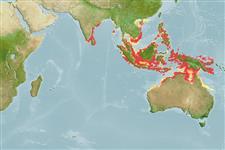Environment: milieu / climate zone / depth range / distribution range
Ecologia
marinhas; Água doce; estuarina; intervalo de profundidade 0 - 50 m (Ref. 189). Tropical; 21°N - 26°S, 76°E - 153°E (Ref. 189)
Indo-Pacific: Indian Ocean (Sri Lanka and India) and western Pacific (Java, Sulawesi, Timor, Ambon, the Philippines and northern Queensland). Presumably more widespread in the Indian Ocean, but not previously separated from Thryssa baelama.
Tamanho / Peso / Idade
Maturity: Lm ? range ? - ? cm
Max length : 10.7 cm SL macho/indeterminado; (Ref. 189)
Espinhos dorsais (total) : 0; Espinhos anais: 0; Raios anais : 24 - 28. Almost identical to T. baelama except in the following: 1 or 2 keeled scutes without arms immediately behind the isthmus, first and second supra-maxilla relatively longer, tip of maxilla blunter and perhaps not always reaching to front border of pre-operculum; also, fewer branched anal fin rays and fewer ;re-caudal but more caudal vertebrae (Ref. 189).
Its habitat and biology is probably similar to T. baelama, but not separated from it in previous records.
Ciclo de vida ou comportamento de acasalamento
Maturities | Reprodução | Spawnings | Egg(s) | Fecundities | Larvas
Wongratana, T., T.A. Munroe and M. Nizinski, 1999. Order Clupeiformes. Engraulidae. Anchovies. p. 1698-1753. In K.E. Carpenter and V.H. Niem (eds.) FAO species identification guide for fishery purposes. The living marine resources of the WCP. Vol. 3. Batoid fishes, chimaeras and bony fishes part 1 (Elopidae to Linophrynidae). FAO, Rome. (Ref. 9822)
Status na Lista Vermelha da UICN (Ref. 130435)
Ameaça para os humanos
Harmless
Uso pelos humanos
Pescarias: pouco comercial
Ferramentas
Relatórios especiais
Baixar XML
Fontes da internet
Estimates based on models
Preferred temperature (Ref.
123201): 27.3 - 29, mean 28.4 °C (based on 538 cells).
Índice de diversidade filogenética (Ref.
82804): PD
50 = 0.5000 [Uniqueness, from 0.5 = low to 2.0 = high].
Bayesian length-weight: a=0.00437 (0.00186 - 0.01024), b=3.11 (2.93 - 3.29), in cm total length, based on LWR estimates for this Genus-body shape (Ref.
93245).
Nível Trófico (Ref.
69278): 3.3 ±0.5 se; based on size and trophs of closest relatives
Resiliência (Ref.
120179): Elevada, tempo mínimo de duplicação da população menor que 15 meses (Preliminary K or Fecundity.).
Fishing Vulnerability (Ref.
59153): Low vulnerability (10 of 100).
